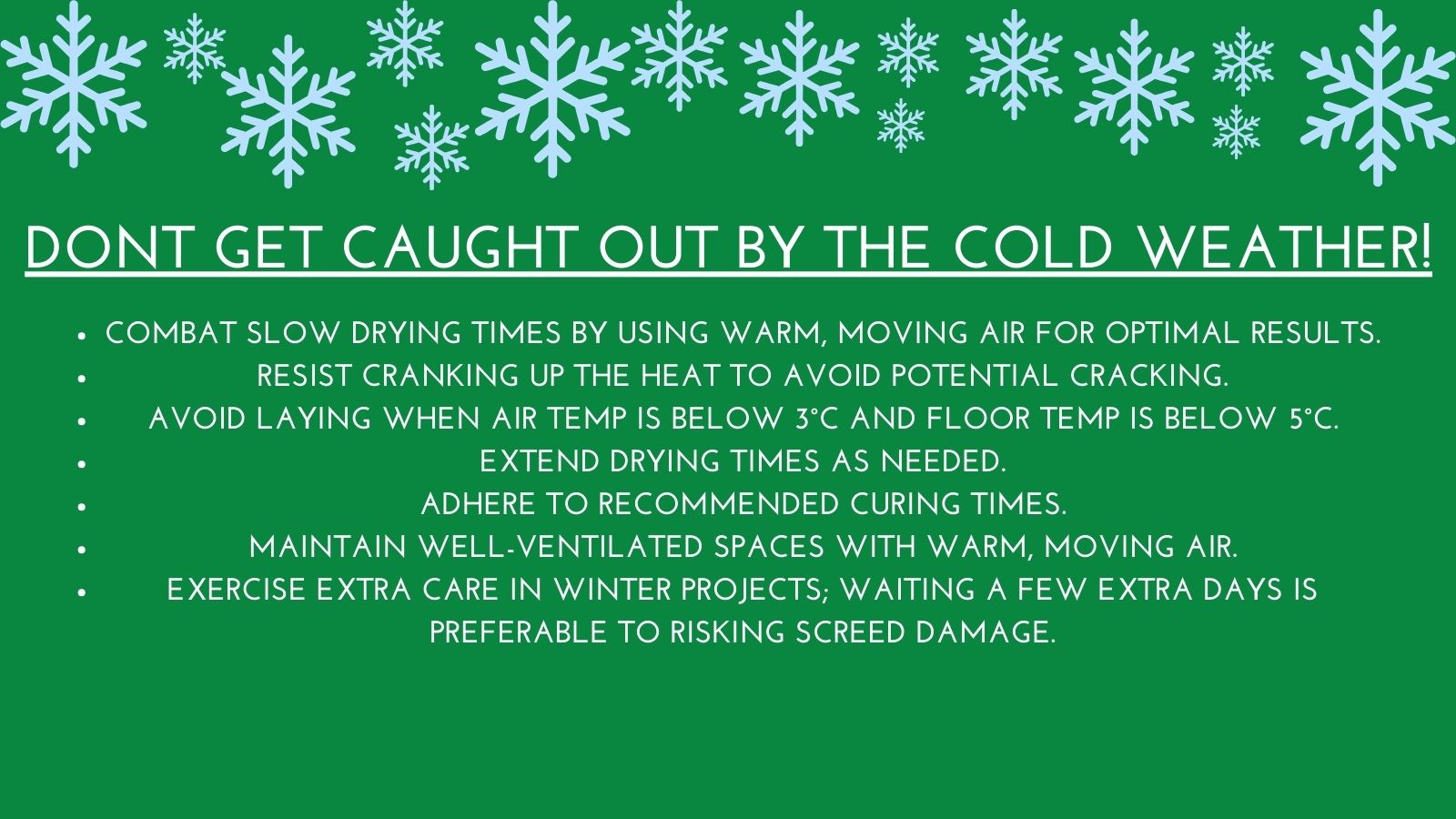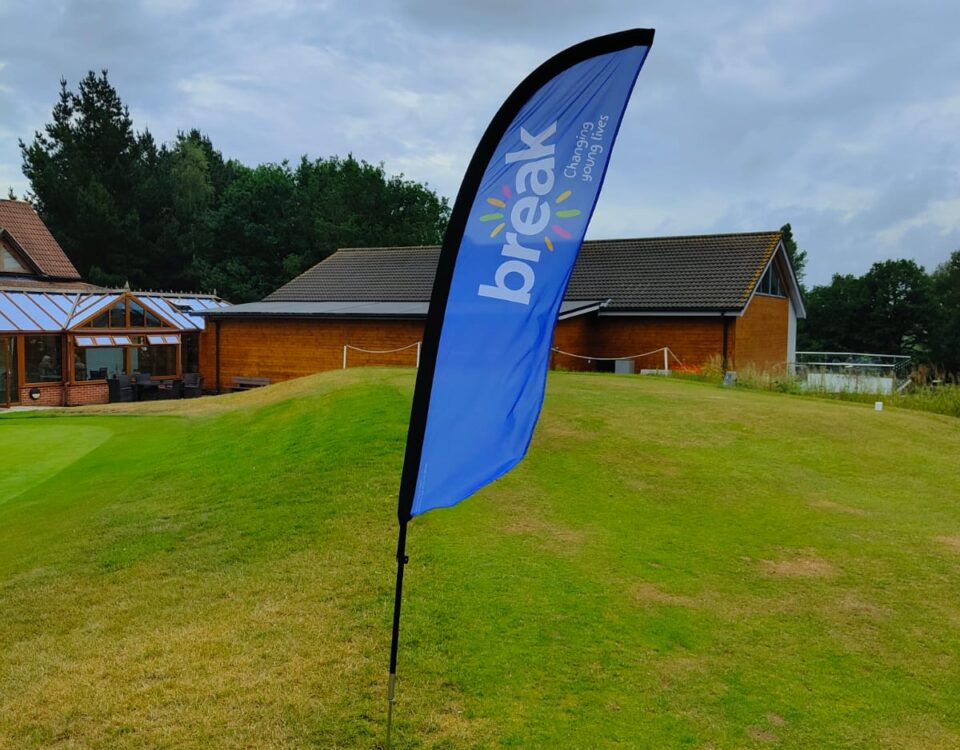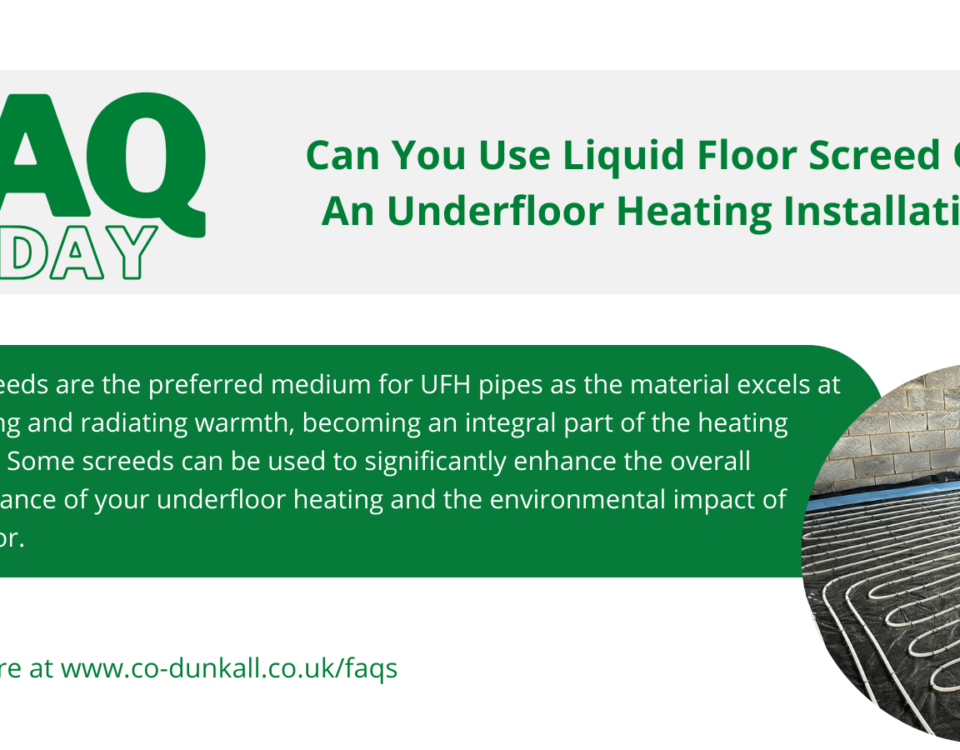Top Tips For Screeding In Colder Weather!
Effectively managing the challenges of screeding during cold weather for your Co-Dunkall Ltd floor screed projects requires a meticulous and strategic approach. Winter conditions can introduce unique hurdles to construction endeavors, demanding careful consideration and precise execution. To ensure the seamless progress of your floor screed projects, even in cold weather, we provide an in-depth guide that goes beyond mere tips. This comprehensive knowledge aims to empower you with the insights and strategies needed to tackle the intricacies of screeding in cold weather under the banner of Co-Dunkall Ltd.
In the chilly embrace of winter, the primary obstacle encountered is the extension of drying times for screed floors. Scientifically speaking, the capacity of cold air to retain water during the evaporation process diminishes, leading to an elongated drying period for your floor screed. To counteract this, the pivotal solution lies in the incorporation of warm, circulating air. This creates an environment conducive to optimal drying conditions, expediting the overall process and enhancing the efficiency of your floor screeding project.
A critical point of emphasis is the avoidance of succumbing to the temptation of cranking up the heat, especially when considering floor screed. While it might seem like a swift remedy for sluggish drying times, it carries the risk of eventual cracking in your floor screed. Temperature fluctuations, especially abrupt increases, can compromise the structural integrity of the screed floor. Therefore, exercising caution and refraining from laying floor screed when the air temperature falls below 3°C and the floor temperature drops below 5°C is paramount for establishing a stable foundation for your Co-Dunkall Ltd floor screed project.
Consideration for extended drying times becomes imperative in the context of cold-weather floor screeding. Traditional drying timelines for floor screed may need extension to accommodate the challenges posed by lower temperatures. Allocating additional time ensures that the floor screed attains the desired level of hardness and durability, contributing significantly to the longevity of the overall structure.
Inextricably linked to drying times for floor screed are the recommended curing periods. Adhering diligently to these prescribed timelines is critical to the screed floor’s ability to achieve the desired strength and characteristics. The curing process for floor screed is a delicate balance of time and conditions, and meticulous observance of these guidelines is integral to the floor screed’s long-term performance.
Ventilation emerges as a pivotal factor in mitigating the challenges associated with cold-weather floor screeding. Ensuring a well-ventilated workspace serves a dual purpose for your floor screed projects. Firstly, it facilitates the efficient dispersion of moisture, expediting the drying process for your floor screed. Secondly, the introduction of warm, moving air contributes to maintaining the optimal conditions required for effective floor screed curing. This emphasis on ventilation becomes a cornerstone in addressing the intricacies imposed by cold weather, ensuring that your Co-Dunkall Ltd floor screed project progresses with resilience and efficiency.
In the realm of customer communication for Co-Dunkall Ltd floor screed projects, transparent and comprehensive guidance is key. Clearly articulating the rationale behind each precautionary measure fosters understanding and confidence among customers. While the inclination to expedite the process by increasing the heat may be tempting, customers need to be informed about the potential risks, such as cracking in the floor screed, that may arise from hasty decisions.
Incorporating regular testing into the screeding process for your floor screed is a proactive measure that further ensures the desired outcomes. Testing serves as a diagnostic tool, enabling the early identification of any deviations from expected results in your floor screeding project. This aligns seamlessly with Co-Dunkall Ltd’s commitment to delivering high-quality results and provides a mechanism for preemptive corrections if needed in your floor screeding projects.
Top Tips For Screeding In Colder Weather!
As we delve into the intricacies of winter floor screeding projects under the banner of Co-Dunkall Ltd, it becomes evident that they demand an elevated level of care and attention. Communicating the importance of patience to customers is crucial, especially when dealing with floor screed. Emphasizing that waiting a few extra days for the screed floor to set and cure thoroughly is a prudent investment in the long-term success of the project. This aligns with Co-Dunkall Ltd’s dedication to excellence, assuring customers that their floor screed projects are in capable hands, even in the challenging conditions presented by winter.
In conclusion, screeding in cold weather for your Co-Dunkall Ltd floor screed projects requires a holistic understanding of the challenges at hand and the implementation of strategic measures to overcome them. From adjusting drying and curing times for your floor screed to prioritizing ventilation and incorporating testing, each element plays a crucial role in achieving optimal outcomes for your floor screeding projects. Effective communication with customers becomes pivotal in managing expectations and instilling confidence in the resilience of the project, reflecting Co-Dunkall Ltd’s commitment to delivering excellence, regardless of the external challenges presented by winter conditions for your floor screed.
Top Tips For Screeding In Colder Weather!
Top Tips for Floor Screeding | Co-Dunkall the Flooring Experts
#screed #underfloor #heating #insulation #norfolk #suffolk #cambridge #essex #anhydrite #anhydritescreed #gyvlon #excelio #flowscreednorfolk #flowingscreednorfolk #AnhydriteScreedVsCemfloor #SelfLevelingFloorScreed #FlooringComparison #FastDryingScreed #StrengthAndDurability #ShrinkageControl #FlooringApplications #ChoosingTheRightScreed #FlooringMaterials #ConstructionMaterials #FlooringSolutions #FlooringProjects #Cemfloor
www.co-dunkall.co.uk
Anhydrite screed vs. Cemfloor




